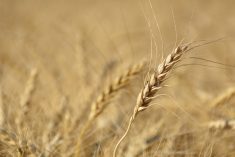Loonie raises fed prices
The average on steers was $96.67 per hundredweight, up $1.21, while heifers were 53 cents higher to $95.30, said Canfax.
The gain was mostly attributed to an almost three percent decline in the Canadian dollar.
Sales volume of 15,500 was down 18 percent from the week before.
The cash-to-futures basis strengthened to $14.43 under compared to $15.48 under the week before.
Fed exports to the United States totalled 11,503 head, down 11 percent from the week before and 50 percent lower than last year.
Show list volumes are anticipated to hit a seasonal low soon and there is still a chance for improved prices, said Canfax.
Read Also

Why feds imposed EV tariffs
Moe and Kinew have a fight on their hands when it comes to eliminating the EV tariff. Canada has to worry about pissing off the U.S. and Mexico and hundreds of thousands of auto workers.
August-placed yearlings have performed well, thanks to exceptional fall weather, and are expected to hit the market soon. American Thanksgiving at the end of the month is expected to slow beef demand.
D1, 2 cows in Alberta were stronger at $32-$48 per cwt. with an average of $39.05. That was $2.81 higher than the week before, Canfax said.
Butcher bull prices were $36-$60 with an average of $50.13, down 84 cents.
Cows and bulls exported to the U.S. totalled 6,167 head.
Beef price strengthens
Tighter fed supplies in the U.S. and smaller slaughter helped drive U.S. Choice cutouts up by $8.34 US to $157.37 while Select climbed $5.15 to $146.49.
The Calgary wholesale price for delivery this week was a little stronger at $163-$166. The Montreal price fell $1 to $163.
In mid October as the loonie dropped sharply, Calgary wholesale prices climbed $10 higher to parity with Montreal’s wholesale, said Canfax. Calgary’s wholesale market demand held up while Montreal’s faltered to freeze prices.
Now that the loonie is back to early October levels, western wholesale prices may soften $2-$3 and improve demand.
Feeder steers stronger
Alberta feeder cattle auction volume dropped 34 percent to 62,723 head. That was up seven percent from a year ago.
Light steer calves traded $2.01-$3.72 per cwt. higher, while heavier steers were 68 cents-$3.02 higher.
Light heifers traded 71 cents-$3.25 higher and heavy heifers were $1.84-$2.51 lower.
Overall, steers averaged 66 cents per cwt. higher and heifers were three cents lower.
Exports to the U.S. totalled 8,600 two weeks ago, down from 10,095 the previous week and 14,726 a year ago.
Feedlot report
The number of cattle on feed in Alberta and Saskatchewan Nov. 1 was 943,789 head, up two percent from last year and a 20 percent increase from last month.
October placements were 325,317 head, up 26 percent from last year. The largest increase was in the lighter than 600 pounds range with 42 percent more animals placed this October compared to 2007. Placements of 600-699 lb. rose 19 percent and 700-799 lb. rose 36 percent. Placements of 800 lb. and heavier rose 17 percent.
Marketings by the Canfax group in October totalled 158,226 head, down eight percent from September and seven percent less than the same month last year. The Canfax survey group represented 78 percent of total actual marketings.
The number of steers and heifers in Alberta and Saskatchewan killed domestically or exported for slaughter in October totalled about 202,000 head, up three percent from September, but down 12 percent from last year.
Disappearance was down 17 percent compared to last year.
Hog prices stabilize
Demand for Thanksgiving and Christmas hams in the United States helped stabilize hog prices, but large supplies of pork still weighed on the market.
Iowa-southern Minnesota cash hogs Nov. 14 dipped to $37.50-$38 US per cwt., down from $38.50 Nov. 7.
The U.S. pork carcass cut-out value climbed above $58 midweek, but then fell to $56.41 Nov. 14 compared to $56.27 Nov. 7.
U.S. federal slaughter to Nov. 15 was estimated at 2.31 million, up from 2.307 million the week before but down from 2.37 million the year before.
Bison steady
The Canadian Bison Association said grade A carcasses from youthful bulls in the desirable weight range in Canada were mostly $2.30-$2.75, with an estimated average of $2.50 per lb. hot hanging weight. Heifers were $2.25-$2.65 per lb. with an average of $2.40.
The cull cow and bull average rose to $1.05 per lb., with sales to $1.40.
Weight, quality and delivery location affect final price.
The U.S. Department of Agriculture’s October bison report said American markets were steady during the month except for aged cows culled to make way for younger breeding stock. Young bulls were $200-$245 US with an average of $239.99. Young heifers were $225-$250, with an average of $230.17 Aged bulls averaged $147.02 and aged cows were $141.71.
Sheep, lambs stronger
Beaver Hill Auction in Tofield, Alta., reported 715 sheep and lambs and 224 goats traded Nov. 10.
The market firmed a little, with off types the hardest to move. Feeder lambs were steady to higher; fat lambs and culls were barely steady.
Good goats heavier than 50 lb. were steady to higher.
Lambs lighter than 70 lb. were $90-$124 Cdn per cwt. Lambs 70-85 lb. were $100-$119, 86-105 lb. were $100-$116 and those heavier than 105 lb. were $100-$111.
Rams were $25-$78 per cwt. Ewes were $20-$60 per cwt.
Good kid goats were $120-$158. Nannies were $30-$70 per cwt. and mature billies were $50-$111.
Ontario Stockyards reported 2,209 sheep and lambs and 172 goats traded Nov. 10. Lighter lambs were $5 to $7 a cwt. lower. Heavy lambs were $2 to $5 lower. Goats were firm. Sheep were $5 per cwt. higher.














